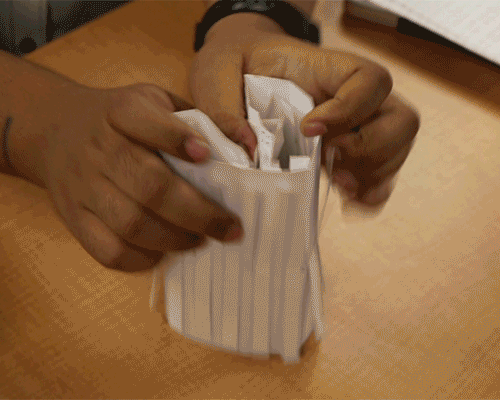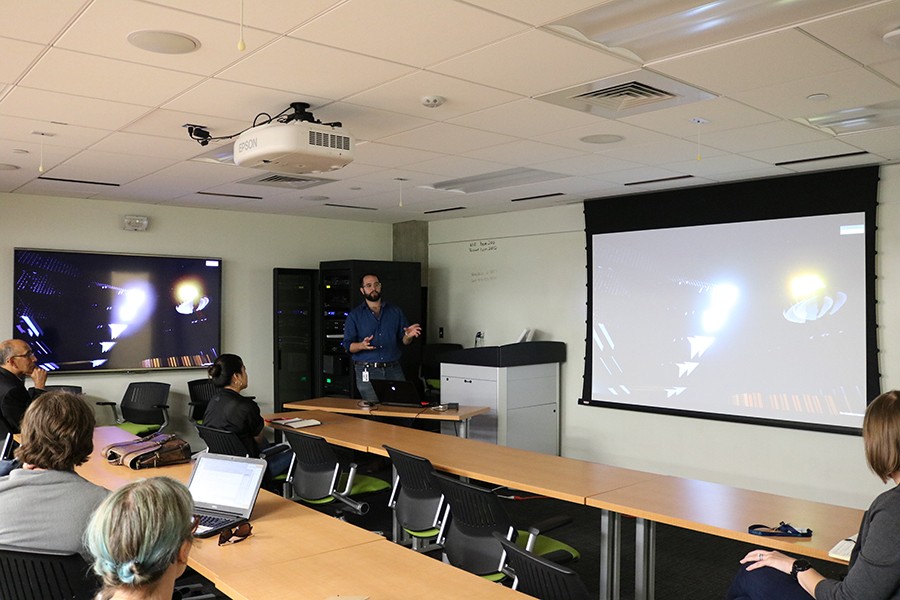Most people consider art and science to be very different endeavors with little to no common ground. But two Maryland Institute College of Art students spent the summer collaborating with researchers at Johns Hopkins University's Hopkins Extreme Materials Institute proving that isn't true.
Nilam Sari and Joshua Gleason were this summer's participants in the HEMI/MICA Extreme Arts program, an initiative created in 2012 to bring faculty and students from both institutions together to examine scientific data, interpret outcomes, and translate results from HEMI's research on extreme events in new and creative ways.
Last week, those students showcased their work in presentations to HEMI researchers and MICA peers.
Sari, an interdisciplinary sculpture major with a concentration in graphic design, worked with Lori Graham Brady, associate director of HEMI, and Benjamin Schafer, a professor in the Department of Civil Engineering, to investigate the use of paper in corrugated designs to make paper structures sturdier. In her project, "Accordion Paper Structure", Sari used shapes and principles found in civil engineering in her attempt to create a woven paper structure that would sustain weight and not fail under pressure. While her project was not as successful as she had hoped, Sari says she learned a lot through her collaboration with scientists and engineers.

Image caption: Nilam Sari used shapes and principles found in civil engineering to create a woven paper structure that would sustain weight and not fail under pressure
Image credit: Hopkins Extreme Materials Institute
"Sometimes, you have to go the long way to reach any type of solution," she said. "We need to learn to collaborate with the material, not the other way around. We can't just magically make it do what we want right away. We need to consider how it reacts and consider that as we work with it."
Gleason, an interactive arts major with a concentration in animation, worked with Mark Robbins, a HEMI fellow and professor in JHU's Department of Physics and Astronomy, and Thomas O'Connor, a graduate student in the same department, to create "A World of Its Own," a computer-based virtual reality gaming experience that allows users to explore different materials at the microscopic level.
Gleason hopes that his creation will spark people's curiosity about science and encourage them to seek more information.
"Curiosity begets the science," he said. "It's so interesting to take knowledge, distill it, and game-ify it. If you're playing the game and engaged, you'll want to learn more about how (the material) works. "
Graham Brady, who spearheads the HEMI/MICA Extreme Arts Program, says the imitiative is not only cultivating a strong, creative, and collaborative community comprising scientists and artists, but it's also helping engineers look at their own work in new ways.
"Visualization is a real challenge for us as engineers," she says. "The designers at MICA are naturally inclined to conveying complex information in very concise ways."
Gwynne Keathley, vice provost for research and graduate studies at MICA, agrees.
"It has been an extraordinary experience working with HEMI," she said. "Having our artists and designers work with scientific researchers extends our understanding of each others' works in ways neither party could have imagined."
The HEMI/MICA Extreme Arts program offers a summer project/internship to MICA students, an artist/designer in residence program to MICA faculty members, and just launched a series of artist workshops to JHU students this year.
Posted in Arts+Culture, Science+Technology
Tagged materials science, mica, johns hopkins extreme materials institute









